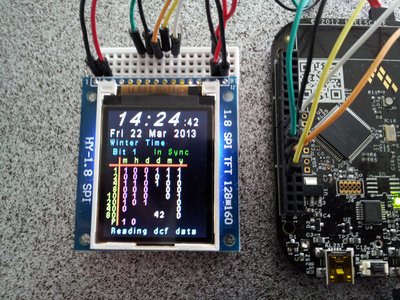DCF77 clock using the HY-1.8 LCD display. Sets KL25Z RTC clock and will continue to run with no DCF signal. Import the libraries to work on FRDM-KL25Z board, sends 8 bit writes to the LCD.
Dependencies: HY-1_8TFT_ST7735 TSI mbed
Fork of KL25Z_DCF77_HY-1_8LCD by
This project shows the KL25Z connected to a very cheap (3 Euros) Chinese TFT LCD Display (HY-1.8 SPI from Ebay). I have modified a ST7753 driver library to work the 8 bit SPI write that the Mbed library sets the FRDM board to (not sure why as the KL25Z MCU has16 bit cababiliy). The libraries are available for import from my home page. and includes five different fonts (three are needed for this example).
I have also used the Analog Out (pin PTE30) to control the LED back light level, simply connect a small NPN transistor in the LED -ve connection to ground and feed the analog out pin to the base of the transistor via a 10k ohm resistor. When you slide your finger across the TSI touch slider the display brightness can be changed from off to full level.
The code it much the same as the other projects I have published, just with different LCD drive code. This program will decode the DCF77 signal connected to pin PTE20 and set the RTC clock. The photo shows the display before I modified the LED backlight drive circuit.
The display runs at 5V and draws arround 20mA, the backlight led will also run at this voltage and is nice and bright. It can also be connected to the USB 3v pin and runs at a lower level. there is a solder jumper to bypass the 5v regulator, leave this open and it will run on both volages, if this jumper is closed it will bypass the regulator and if connected to the 5v supply, the display will be 'bricked' so take care!.
This display is considerably better and cheaper than the Nokia display but not as good as Oled. Easy to connect, 5 data connections and 2 power wires. It also includes a SD card slot that can be connected to the FRDM board.
The backlight is LED it does not use a switch mode DC-DC converter circuit so RF noise is very low, this is essential when using a sensitive VLF DCF77 radio receiver close by.
The FRDM board and display runs at 50mA depending on LED brightness.

main.cpp
- Committer:
- smultron1977
- Date:
- 2011-12-12
- Revision:
- 0:2353da390056
- Child:
- 1:6f4c5876140d
File content as of revision 0:2353da390056:
/** ST7735 Pong by Jonne Valola, derived work from William Johnston's mbed Pong for NokiaLCD / PS2 keyboard
* This pong uses a rotary encoder hooked to pins 21 and 22,
* ST7735_TFT library by me, RotaryEncoder library by Shinichiro Nakamura
* All copyrights of respective owners. Use on your own risk and discretion.
*/
#include "mbed.h"
#include "ball.h"
#include "paddle.h"
#include "ST7735_TFT.h"
#include "string"
#include "Arial12x12.h"
#include "Arial24x23.h"
#include "RotaryEncoder.h"
RotaryEncoder re(p21, p22, 0, 600, 300);
// State enumerator
typedef enum {
RESET, RUN, PAUSE
} STATES;
ST7735_TFT lcd(p5, p6, p7, p8, p11, p15,"TFT"); // mosi, miso, sclk, cs, rs, reset
/*
* Subroutine drawScreen:
* Description: Draws both paddles
* and the ball.
*/
void drawScreen(Paddle paddle1, Paddle paddle2, Ball theBall, bool isBlack) {
paddle1.draw(lcd, isBlack);
paddle2.draw(lcd ,isBlack);
theBall.draw(lcd ,isBlack);
}
/*
* Subroutine drawScores:
* Description: Draws the scoreboard
*/
void drawScores(Paddle paddle1, Paddle paddle2) {
lcd.locate(60,1);
lcd.printf("%d", paddle1.getScore());
lcd.locate(90,1);
lcd.printf("%d", paddle2.getScore());
lcd.fillrect(79,0,81,128,0xFFFFFF);
}
int main() {
lcd.background(0x000000);
lcd.cls();
lcd.set_orientation(1);
lcd.set_font((unsigned char*) Arial12x12); // select the font
Paddle paddle1, paddle2;
Ball theBall;
int temp, count=0, oldY;
drawScreen(paddle1, paddle2, theBall, false);
drawScores(paddle1, paddle2);
STATES state = RESET; // Initial state is RESET
while(1) {
switch(state) {
case RESET: // Reset objects, draw the screen, state = PAUSE
lcd.cls();
paddle1 = Paddle(0,40,5,25,0xFFFFFF,paddle1.getLives(),paddle1.getScore());
paddle2 = Paddle(154,40,5,25,0xFFFFFF,paddle2.getLives(),paddle2.getScore());
theBall = Ball(80,64,5,5,0xFFFF00,1,1);
drawScreen(paddle1, paddle2, theBall, false);
drawScores(paddle1, paddle2);
oldY = re.getVal();
state = RUN;
break;
case RUN:
if (oldY > re.getVal()) { // Executes if encoder turned
if(paddle1.getY()>2)
paddle1.move(lcd, -2);
}
if (oldY < re.getVal()) { // Executes if encoder turned
if(paddle1.getY()+paddle1.getHeight()<128)
paddle1.move(lcd, 2);
}
oldY = re.getVal();
if(count%2) // Only let CPU move once every 2 times through the loop
paddle2.moveCPU(lcd, theBall.getY());
if(++count==5) { // Only move the ball once every 5 times through the loop
count = 0;
if(theBall.hitP1((paddle1.getX()+paddle1.getWidth()), paddle1.getY(), paddle1.getHeight()))
theBall.reverseX();
if(theBall.hitP2(paddle2.getX(), paddle2.getY(), paddle2.getHeight()))
theBall.reverseX();
if(theBall.hitX()) { // If the ball hits one of the sides of the screen
if(theBall.getX()<7) { // If the ball hit paddle1's side
paddle2.addPoint();
}
else if(theBall.getX()>153) { // If the ball hit paddle2's side
paddle1.addPoint();
}
theBall.reverseX();
state = RESET; // Reset the objects
}
if(theBall.hitY())
theBall.reverseY();
theBall.move(lcd);
}
break;
}
drawScreen(paddle1, paddle2, theBall, false);
drawScores(paddle1, paddle2);
}
}
